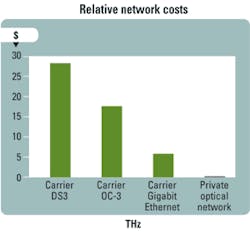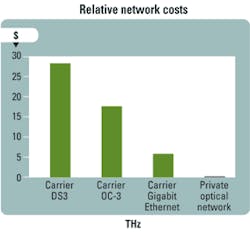by Robert Michaels and Michael O'Brien
In the last 25 years, equipment innovations such as the commercial router and low-cost Ethernet have enabled enterprises to expand and more effectively compete through the aggressive deployment of large private networks. The individual links between locations such as office parks and data centers, however, are still largely provided by telecommunication carriers�at a significant associated expense.
The advent of economical dark fiber in metropolitan areas throughout the world and cost-effective, easy-to-use optical transport equipment built for the enterprise requirements has challenged this paradigm. Organizations now can easily justify a private optical network to connect locations in metro and regional areas thanks to the benefits available bandwidth and lowered network costs provide.
Mean price for a 45-Mbit/sec DS3 in a typical U.S. metro market is around $1,271 per month and can range as high as $2,200 monthly, according to a survey by Broadband Asset Strategies LLC. In the same areas, a typical dark fiber connection usually costs about $10,000 per month on a lease of a few years. In many cases, municipal fiber sources or longer leases can reduce the price precipitously; however, on the face of it, dark fiber would not appear to be a competitive alternative to a leased circuit. To understand why dark fiber indeed is a better approach, one must consider the possibilities that fully utilizing that fiber provides.
The simplest way to utilize dark fiber is to connect a long-range optical module on a router or switch at either end of the span. However, fiber truly starts to shine competitively when optical multiplexing equipment enters the picture. Many service providers currently use DWDM to transport multiple network services over a single dark fiber pair, resulting in hundreds of gigabits of usable bandwidth. Unfortunately for the enterprise, the majority of DWDM equipment is built specifically for these telecom service providers and is accordingly costly and complex.
Fortunately, DWDM equipment that is tailored for the corporation, both in cost and ease of use, now has appeared on the market. Depending on distance, a capital investment of less than $50,000 per node provides up to 25 Gbits/sec of bandwidth (e.g., 10 channels of 1 to 2.5 Gbits/sec of service) over a single dark fiber pair. Double that investment and available bandwidth jumps to 100 Gbits/sec (e.g., 10 channels of 10-Gbit/sec service each). In terms of pure recurring expense, building this 100-Gbit/sec network gives the deploying company more than 2,000 times the bandwidth of a single DS3 for a monthly bill less than 10 times larger (based on the previous figure of $10,000 per month for dark fiber). For a typical large enterprise, which often purchases many DS3 or faster services between locations, the dark fiber approach can provide massive cost savings and increase available bandwidth substantially.Consider the comparison another way: The DS3 at $1,271 per month is really $28 per megabit/second per month. Including the amortized capital investment and leased dark fiber, the aforementioned 100-Gbit/sec link provides a granular cost of $0.15 per megabit/second per month (again, $10,000 for the dark fiber, plus $200,000 in capital equipment costs, $20,000 in construction costs, and with capital costs amortized over 5 years at a 15% cost of capital). Even with the quantity discounts that service providers are touting for Gigabit Ethernet circuits, price per megabit/second per month only approaches $5, still 33 times more expensive per megabit/second than deploying your own fiber network.
With this kind of economy, corporations realize unheard of flexibility in just how business is organized. The location of servers and workers becomes more flexible, resulting in real estate savings and increased personnel efficiency. Backups for disaster recovery, even of massive data stores, can be done live over the network, saving the time and cost of moving tapes, disks, or optical media. Use of high-bandwidth applications between regional and metro locations becomes the norm. The bandwidth that an economical private optical network provides allows the business planner substantial freedom of choice.
To build an optical network, one needs access to a useful fiber-optic cable infrastructure. During the �bubble years� of the late 1990s through 2001, companies invested heavily in fiber infrastructure, only to lose these assets to discounted buy-outs or litigation when the �bubble� burst. Today, much of that fiber built in metropolitan areas remains unused and available at a very reasonable price. This situation presents a wonderful opportunity for enterprises, which now have access to the very same type of fiber-optic cable infrastructure that service providers use.
Getting the fiber to your facilities provides the first challenge. First off, it never hurts to walk around the parking lot and surrounding sidewalks looking at manhole covers for �fiber optics� markings. This indicates a fiber vault, and may mean that you already have fiber in your building. At any rate, note any markings you find on or around these manholes.
When looking for a fiber supplier, skip the local phone company; they typically do not sell dark fiber and choose to focus on value-added lit services. However, there are many companies that are more than happy to provide dark fiber. Vendors who supply DWDM equipment for the enterprise often have valuable relationships with these providers and should be your first resource when searching for them. One interesting source to look into is your local utilities. For instance, the Los Angeles Department of Water and Power is a great supplier of dark fiber in Southern California.
Once a path has been identified, there may be some construction required to get the connection to a particular building. The construction usually is not much more than digging up a parking lot to reach a nearby fiber vault. Depending on the fiber provider, the cost of construction may be amortized over the length of your fiber lease. For 20 m of parking lot/street conduit to be built, the upfront cost generally hovers around $10,000.
After getting fiber into your facility, all you need is equipment to light it, which leads to what used to be a major impediment to building a private optical network: the complexity of traditional DWDM systems. As previously mentioned, new equipment tailored for the enterprise is now available. With these systems, in metro areas where total fiber distance is less than 80 km, the only optical parameter one is required to know is simple signal loss over the span distance; this is readily available from your dark fiber supplier. Once this number is known, just take the output power provided by the vendor, subtract the signal loss, and compare the result to the receiver sensitivity provided by the vendor. If the result is the higher of the two numbers, the link will perform as expected barring rare issues.
Sometimes the loss within a fiber span�even at a relatively short distance in rare circumstances�can be too high for the output power and receiver sensitivity of a given system. This is usually caused by a large number of splices or patches in the span. For most simple network topologies (i.e., point to point or ring with a few nodes), the addition of amplification can solve this problem. Most manufacturers of DWDM systems offer an amplification option, and the vendors of the new enterprise systems are no exception. The most common amplifiers used in metro situations are narrow- and wideband erbium-doped fiber amplifiers. For a simple 10-channel network, a narrowband amplifier located just before the receiver provides just enough additional sensitivity to satisfy the power requirements.
For distances greater than 80 km, simple amplification will not be enough when per-channel rates reach 10 Gbits/sec due to a phenomenon known as �chromatic dispersion.� This dispersion, present in all optical transmission, is caused by the differences in phase velocity of the different wavelengths of light as they pass through the fiber. This is corrected with the insertion of special dispersion-compensating fiber or a device known as a Bragg grating into the fiber span. Once again, all DWDM manufacturers, including those building enterprise-focused systems, sell such fiber and modules. For both amplification and dispersion compensation, the new vendors often integrate the options into the unit at purchase time, which reduces the complexity of fiber interconnection and module configuration.
Aside from the optical complexity, traditional DWDM systems were a nightmare for enterprise network architects due to management standards developed specifically for the telecom market. From basic TL1 to proprietary Java-based Web interfaces that emulate TL1, these standards are outside the skill set of most corporate network administrators. The new generation of enterprise-focused vendors has addressed such management complexity as well. For example, at least one vendor has implemented a router-style command line interface, as well as enterprise-familiar TCP/IP, SNMP, and syslog management standards.
Early adopters of commercial routing and Ethernet switching products benefited in two ways. First, they took control of their data needs from service providers, which reduced costs and increased flexibility. Second, they changed how they did business to take advantage of what this new technology afforded them. As they learned about Layer 3 and Layer 2 networking, the corporations added new capabilities that still pay dividends today.
Now that same opportunity exists at the physical layer. A corporation that controls its own fiber has the ability to drastically improve its data networking capabilities via access to huge amounts of economical bandwidth. These are times of plenty for bandwidth, and it�s an opportunity any company would be wise to investigate.
Robert Michaels is director of business development and chief engineer and Michael O�Brien is marketing director at XKL LLC (www.xkl.com).

